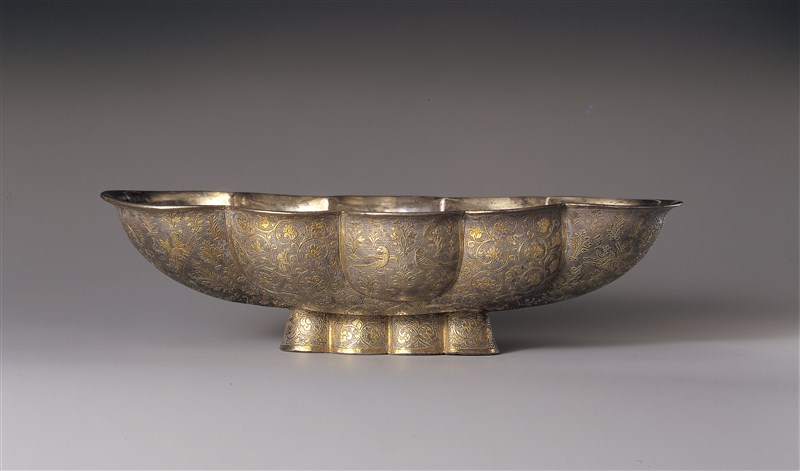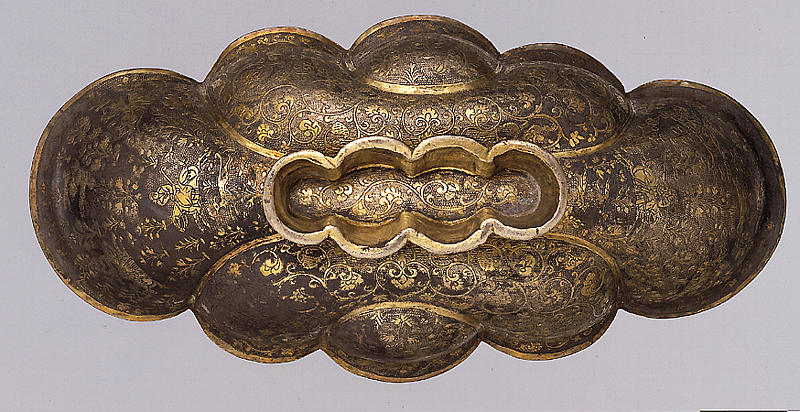花鳥狩猟文八曲杯
- 中国
- 中国・唐時代
- 7世紀後期-8世紀中期
- 銀鍍金
- H-4.7 D-17 W-8.5
この器の大半を覆っている唐草文様はペルシャ由来であり、その起源はおそらくローマの葡萄文に相当すると思われる。器型はペルシャの七種の供物を盛ったという同型の儀器に由来すると考えられている。ペルシャでは通常より大きく扱われる狩猟の要素も、背景の意匠化された草原の点景として扱われ、叙事的、象徴的な事柄からは遠ざかったより美的な配慮が強調されていると言えるであろう。
Catalogue Entry
Asia's famous Silk Route swept across northern China, past Central Asia, into Persia, and through Arabia before arriving at the edge of the Mediterranean Sea to connect Tang-period China (A.D. 618-907) with the West and parts in-between. Merchants, missionaries, and government ministers constantly traveled this route, their final destination being the Tang-dynasty capital of Chang'an (present-day Xi'an), where commerce and cultural exchanges took place. According to the Six Books of Tang Institutions, the country maintained diplomatic relations with over 300 nations and areas and even established a protocol department whose job it was to welcome the visitors, provide them with interpreters and even supply them with the daily necessities.1
Among the foreigners living in Chang'an, the Persians held a prominent position in the foreign trade community and controlled the city's medicine, spice, and metalwork markets.2 Art from Persia and the Central Asian region of Sogdiana had a major impact on Chinese metalwork created during this time.3 An especially popular Persian metalwork shape was an eight-lobed wine cup, which served as a model for the one in the Shumei collection.
Wine cups were not new to China, and oval-shaped lacquer forms, with ear-shaped handles flanking the cup sides, can be traced to the Spring and Autumn period (771-476 B.C.). Although that shape continued to be made in metal and jade, polylobed cups from the Near East held special fascination for Tang Chinese metalworkers.4 Persian polylobed metal forms, a five-lobed silver variation of which was unearthed in Mazanderan, south of the Caspian Sea, can be traced to the third century.5 By the fourth century, multilobed cups were used in China as well, as is documented on a wall painting in China's northwestern province of Xinjiang.6
Eight-lobed cups produced in Persia made their way to China by the fifth century, and by the early years of the Tang period, eight-lobed bowls were already in vogue with the aristocracy, as illustrated on the walls of Emperor's Li Shou's tomb, where a court lady carrying an eight-lobed example has been engraved.7 It seems that during the early Tang-period eight cups were the rage; however, by the end of the dynasty, four-lobed vessels appear more popular.8
To create the Shumei cup, initially an oval sheet of silver was raised and hammered into an eight-lobed oblong form before a six-lobed oval-shaped foot was attached.9 The interior of the cup is devoid of design, but its exterior surface is patterned with a variety of chased and gilt motifs derived from the Near East. The center front and back panels of the cup feature several pairs of birds resembling parrots and geese set amongst so-called tree of life motifs and foliage. The right and left panels flanking the front and back center panels have chased and gilt curvilinear vine and palmette patterns, motifs especially popular in Persian decorative arts.10 Two larger lobed sections on either end of the cup feature three mounted hunters within Persian-style landscape scenes.11 Small circular designs, created by hammer tapping a small chasing tool with an indented tip on the vessel's silver surface, cover the remaining portion of the exterior surface and provide a ring-matted ground design in low relief.
Both gold and silver four-lobed cups have been unearthed around the ancient capital of Chang'an in Shaanxi province.12 An outstanding eight-lobed cup is in the collection of Hakutsuru Art Museum, Kobe, Japan.13 In the West, almost an exact replica of the Shumei cup can be found in the Pierre Uldry collection in Switzerland, and a eight-lobed silver cup is also in the Asian Art Museum of San Francisco.14
JMS
1. Wang 1992, p. 186.
2. Wang 1992, p. 187.
3. Kaogu 1994.2, pp. 174-82.
4. Wenwu 1996.5, pp. 43-46; see Yang 1994, p. 71 for a Tang-period silver-gilt ear cup, and p. 77 for a jade polylobed version.
5. Wenwu 1996.5, p. 43, p. 45, fig. 19.
6. See ibid., fig. 18, for line drawings of a cup from a Kizil wall painting.
7. See ibid., p. 36, fig. 3, for line drawing of a court woman carrying a lobed cup which was engraved on Li Shou's tomb walls. For line drawings of Persian and Tang-period lobed bowls see ibid., p. 47, fig. 24.
8. See Zhenjiang bowuguan Shaanxi sheng bowuguan 1985, pl. 245, fig. 246, for a gold, four-lobed cup excavated from Taiyi Road, Shaanxi province; pl. 155, fig. 156, for a silver four-lobed example. Motifs derived from outside of China seem more popular for eight-lobed examples whereas more indigenous motifs appear to be favored for four-lobed versions.
9. Technical information courtesy of Pieter Meyers and Richard H. Kimball; Kimball believes that the base of this cup was cast, while Meyers asserts that it was hammered into its shape.
10. For "tree of life" design see below, cat. no. 133, n.5; on the grape and vine design see cat. no. 137; for an example of Persian palmette motif see Metropolitan Museum 1996, no. 15; and for a Persian bowl with appliqué of palmette designs see above cat. no. 36.
11. For the Persian "flying gallop" motif see cat. no. 131.
12. For a four-lobed gold cup see also the Cultural Relics Division 1994, pl. 308. For a silver example see Zhenjiang bowuguan Shaanxi sheng bowuguan 1985, pl. 155, fig. 156.
13. Wenwu 1996.5, p. 47, fig. 24.
14. Uldry 1994, p. 153, fig. 139; Kelly 1984, p. 65.

